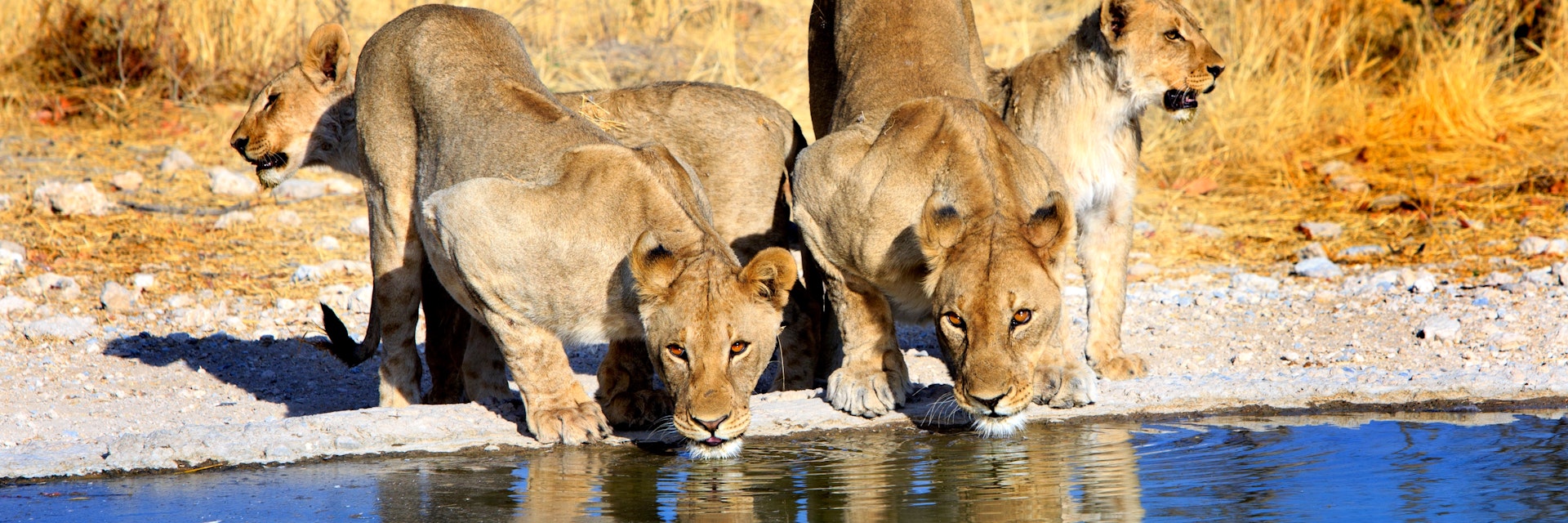Etosha National Park, covering more than 20,000 sq km, is one of the world’s great wildlife-viewing venues. Unlike other parks in Africa, where you can spend days looking for animals, Etosha’s charms lie in its ability to bring the animals to you. Just park your car next to one of the many waterholes, then wait and watch while a host of animals – lions, elephants, springboks, gemsboks etc – come by not two by two but by the hundreds.
Etosha's essence is the vast Etosha Pan, an immense, flat, saline desert that, for a few days each year, is converted by rain into a shallow lagoon teeming with flamingos and pelicans. In contrast, late in the dry season, everything, from the elephants to the once-golden grasslands, seems cast, spectre-like, in Etosha’s white, chalky dust. And what wildlife there is! Even if you’ve had a taste of African wildlife watching previously, you are likely to be mesmerised by it here.
Etosha is home to 114 mammal species as well as 340 bird species, 16 reptile and amphibian species, one fish species and countless insects. The opportunity to see black rhinos is a big draw here; they are usually very difficult to spot, but as they come to some of the waterholes around the camps by night, it couldn’t be easier! Depending on the season, you may observe elephants, giraffes, Burchell’s zebras, springboks, red hartebeests, blue wildebeest, gemsboks, elands, kudus, roans, ostriches, jackals, hyenas, lions and even cheetahs and leopards. Among the endangered animal species are the black-faced impala and the black rhinoceros. Etosha is Namibia's most important stronghold for lions, with more than half of the country's wild lions – 450 to 500 of them, according to the last estimate by peak conservation NGO Panthera (www.panthera.org).
The park’s wildlife density varies with the local ecology. As its Afrikaans name would suggest, Oliphantsbad (near Okaukuejo) is attractive to elephants, but for rhinos you couldn’t do better than the floodlit waterhole at Okaukuejo; we've also seen them by night at the waterhole at Olifantsrus and Halali. In general, the further east you go in the park, the more wildebeest, kudus and impalas join the springboks and gemsboks. The area around Namutoni, which averages 443mm of rain annually (compared with 412mm at Okaukuejo), is the best place to see the black-faced impala and the Damara dik-dik, Africa’s smallest antelope. Etosha is also home to numerous smaller species, including both yellow and slender mongoose, honey badgers and leguaans (water-monitor lizards).
In the dry winter season, wildlife clusters around waterholes, while in the hot, wet summer months, animals disperse and spend the days sheltering in the bush. In the afternoon, even in the dry season, look carefully for animals resting beneath the trees, especially prides of lions lazing about. Summer temperatures can reach 44°C, which isn’t fun when you’re confined to a vehicle, but this is the calving season and you may catch a glimpse of tiny zebra foals and fragile newborn springboks.
Birdlife is also profuse. Yellow-billed hornbills are common, and on the ground you should look for the huge kori bustard, which weighs 15kg and seldom flies – it is the world's heaviest flying bird. You may also observe ostriches, korhaans, marabous, white-backed vultures and many smaller species.
The best time for wildlife drives is at first light and late in the evening, though visitors aren’t permitted outside the camps after dark. While self-drivers should definitely wake up at twilight, when animals are most active, guided night drives (N$600 per person) can be booked through any of the main camps and are your best chance to see lions hunting as well as the various nocturnal species. Each of the camps also has a visitor register, which describes any recent sightings in the vicinity.
You'll find maps of Etosha National Park across the country and at the shops at most of the park gates. NWR's reliable English-German Map of Etosha (from N$40) is the pick and also most widely available. It has the added bonus of park information and quite extensive mammal and bird identification sheets.
Etosha's three main entry gates are Von Lindequist (Namutoni), west of Tsumeb; King Nehale, southeast of Ondangwa; and Andersson (Okaukuejo), north of Outjo.
